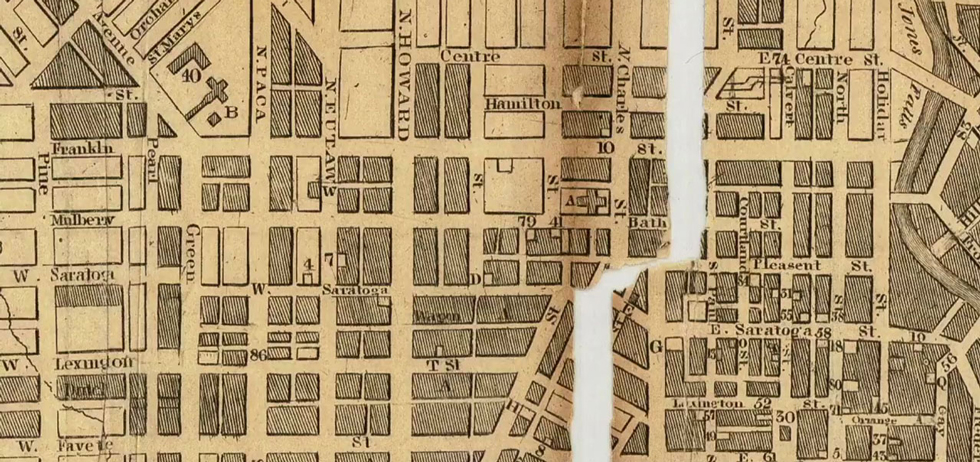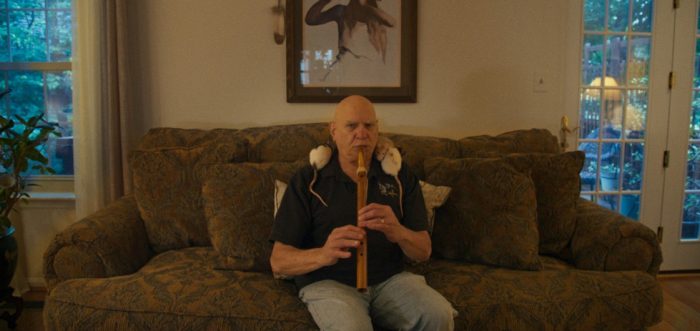
The camera is placed above a metal trash can. Inside, a rat attempts to jump out, its eyes glowing in the reflection of an external light source. A woman narrates: “The adult Norway rat can jump 32 inches high. Baltimore City trash cans are 34 inches high.” The rat is trapped by design. This piece of iPhone footage, the first shot director Theo Anthony captured for Rat Film, sets up the film’s wider investigation into how the structures of the city of Baltimore work to segregate perceived undesirables – in both rat and human form – from the rest of society.
Rat Film operates in a discursive, associative documentary mode, largely avoiding the coming-to of conclusions in favour of a rat king of intimations. Acting as writer, cinematographer, editor and director, Baltimore-based Anthony pieces together his feature-length debut from a wildly disparate mix of materials. Interviews with locals mix with slice-of-life streetscapes, Google Earth screen captures and historical documents. This collection of floating parts is held together by the formal constants of Maureen Jones’ voiceover and Dan Deacon’s spectral synth score. Sometimes, the experience of watching Rat Film feels like browsing the internet with too many tabs open.1
Anthony counts essay film pioneers Harun Farocki and Chris Marker among his favourite filmmakers, and as is the case with many feature-length debuts, Rat Film carries with it the distinct weight of its stylistic forebears. The clinical female voiceover narration recalls that of both Marker’s Sans Soleil (1983) and Farocki’s Images of the World and the Inscription of War (1988) – two films often used in attempts to delineate the slippery form of the essay film. Rat Film’s narration shares the same clinical yet poetic manner of speech, the same removed yet personal tone, the same application of an unreliable narrative voice to complicate the documentary image – the same mystery female conduit between director and audience.
Frequently incorporating computer graphics into its unconventional excavation of Baltimore’s “rat problem”, Rat Film also takes strong aesthetic cues from Marker’s 1997 video game meditation Level Five, and especially Farocki’s four-part installation Parallel I-IV (2012–14), which uses excerpts from video games accompanied by essayistic voiceover. Directly following Rat Film’s title card, we are presented with a trip down a virtual Baltimore street, accompanied by voiceover: “Presentation of a video game. A satellite map of Baltimore is loaded into the program. A 3D terrain is created. The user assumes the role of a floating point within the game: a null object.” This sequence works to position the viewer as this floating point, the null object to be guided by Anthony in the program that is Rat Film. Later, the viewer assumes the perspective of a rat in a computer game navigating a virtual cage.

In this regard, I am reluctant to attribute Rat Film with the high level of formal inventiveness other reviewers have praised it for – Anthony is riffing on pre-existing material. However, that’s not to say that Rat Film is a just an inferior cover version. It exists for a reason. Rat Film draws a pertinent political analogy between the Baltimore city council’s attempts to exterminate the rat population and the long history of racial segregation in the city’s neighbourhoods. Anthony traces this back to 1911, when the first housing segregation ordinance was implemented. Later ruled unconstitutional, the ordinance was ostensibly introduced to “preserve peace, prevent conflict and ill feeling between the white and coloured races in Baltimore” – instead working to instill an entrenched social inequality that continues to plague the city.
Towards its conclusion, Rat Film posits a utopian future, where the city is destroyed, and a New Baltimore is built in its place. “It is July Fourth in Baltimore, and the entire population has gathered on a hillside to watch the complete and final demolition of the city,” Accompanied by slow-motion shots of crowds watching fireworks and delighted citizens on merry-go-rounds, scored to pulsating synth, this passage again recalls Marker in its La Jetée-esque fusion of science-fiction narration and the documentary image. The vision continues: “Private property will be raffled at every corner store. An elite rat task force will be created. There will be trash pick-up every day. Streets will glisten.” The tongue-in-cheek rat-free oasis Anthony offers acts as a signal to the audience: this is not the kind of film that’s going to pretend to offer legitimate answers.
If a conclusion is meant to be drawn from Anthony’s unconventional investigation, it’s perhaps best summarised by a remark from the film’s anti-hero of sorts, council rat exterminator Harold Edmond, who notes: “There ain’t ever been a rat problem in Baltimore, it’s always been a people problem.” The film ends with a close-up of a snake holding a rat foetus in its mouth, preparing to devour it. It’s an image that recalls Herzog in its reflection of the cruel indifference of nature, and while Anthony’s assortment of images is too scattered to reach a Herzogian level of profundity, they hold a power and vision that lingers.
